100 Feet Long: 20 Incredible Things That Will Amaze You!
100 feet long means something that measures one hundred feet from one end to the other. It equals 30.48 meters or 1,200 inches. This length can describe both man-made structures and natural wonders.
Imagine something as long as a blue whale or a 10-story building. That’s how big 100 feet really is. It’s a size that surprises people when they see it in real life.
You can find things that are 100 feet long in sports, nature, and architecture. From semi-trailer trucks to trees and airplanes, this length appears everywhere. It helps us understand scale and proportion in the world around us.
How Big is 100 Feet?
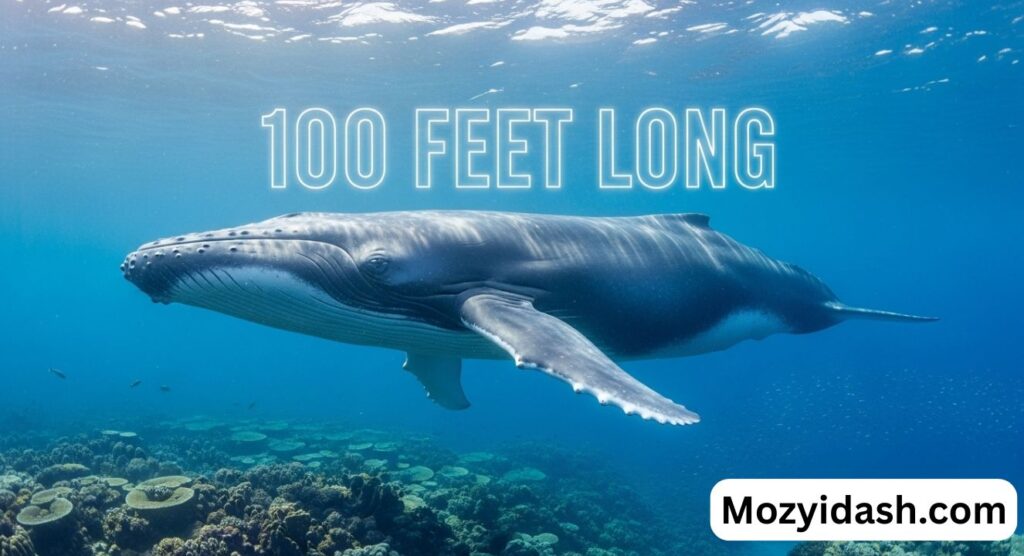
Before diving into examples, let’s understand how big is 100 feet in simple terms. A length of 100 feet is equal to 1,200 inches, or 30.48 meters, which is also 0.03048 kilometers. If you’ve ever wondered what is 100 feet in real life, it’s about the same as the height of a 10-story building or the length of two semi-trailer trucks parked end to end. It’s also just a little longer than the length of a basketball court, which measures about 94 feet.
Here’s a quick length comparison chart to help visualize these numbers:
| Measurement | Equivalent to 100 Feet |
| Meters | 30.48 m |
| Inches | 1,200 in |
| Kilometers | 0.03048 km |
| Basketball Courts | ≈ 1.06 courts |
| Semi-Trailers | ≈ 2 trailers |
| Football Field Dimensions | ≈ 1/3 of the field |
| Bowling Lane Length | ≈ 1 and 1/3 lanes |
These size and distance examples show that 100 feet in meters or 100 feet in inches can represent a very large span, but one that we can still relate to through familiar things. By visualizing measurements, we start to see how scale and proportion shape our surroundings in both everyday measurement examples and impressive natural wonders of size.
What Measures 100 Feet in Length?
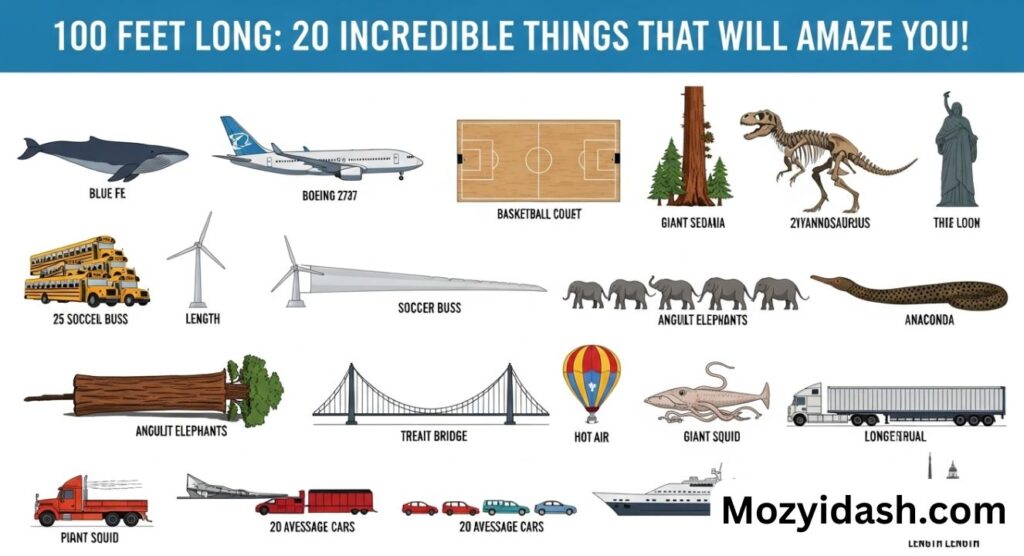
Now that we know how long is 100 feet, let’s explore 15 things that measure 100 feet in length. These 100 feet examples in real life will give you a clear perspective on 100 feet, helping you compare objects that are 100 feet and see how this distance appears in nature, sports, and engineering.
1. 1 and 1/3 of a Bowling Lane
A bowling lane length from the foul line to the pins is about 60 feet. If we extend that by one-third more, we get roughly 100 feet long. Imagine walking down a bowling alley and then adding half that distance again—that’s your 100 feet comparison in action. To make it even more interesting, if you lined up bowling pins end to end, it would take about 80 pins to cover this same distance. Bowling lanes are perfect everyday measurement examples that help you understand how big is 100 feet without any fancy tools.
2. 2/3 of an Olympic Swimming Pool
The Olympic swimming pool size is standardized at 50 meters, which is about 164 feet. Two-thirds of that equals roughly 33 meters or 108 feet, almost exactly 100 feet long. So when you swim from one end to about two-thirds of the way across, you’re covering objects that are 100 ft in length in one smooth motion. Professional swimmers often use this measurement to time laps and improve performance, making it a great real-world length example of distance.
3. A 10 Story Building
If you’ve ever stood next to a medium-sized apartment complex or office block, you’ve seen how tall 100 feet can be. Each floor of a building usually measures around 10 feet in height, so a 10 story building height reaches about 100 feet. This construction measurement gives us a clear sense of how big is 100 feet in vertical scale. Looking up at such a structure helps people appreciate comparison of large objects and how human design can mirror the height of natural wonders of size like tall trees or cliffs.
4. A Basketball Court
A standard length of a basketball court in the NBA measures 94 feet, just six feet shy of 100 feet. This makes it a great 100 feet comparison for sports lovers. When you see players running from one baseline to the other, they’re nearly covering 100 feet in one sprint. This simple observation helps anyone understand what is 100 feet in action and shows how athletic performance relates to understanding distances in measurable ways.
5. A Blue Whale
When talking about large animals in nature, the blue whale size is unmatched. This majestic creature, the largest living animal on Earth, can reach up to 100 feet long. That’s about the same as three school buses lined up! The whale heart size alone can be around 5 feet, and if you lined up 20 of those hearts, you’d reach the same 100 feet length. Seeing a full-sized blue whale model in a museum or ocean park offers an unforgettable real-world length example that brings this distance to life.
6. 1/3 Of A Football Field
The football field dimensions in American football are 360 feet from one end zone to the other. That means walking 100 feet would take you about a third of the way down the field. This everyday measurement example gives a clear perspective on 100 feet, especially for sports fans who’ve watched players run incredible plays across the turf. Standing on that field and pacing out this distance makes it easier to understand how long is 100 feet in real life.
7. Two Semi-Trailers
If you’ve driven on a U.S. highway, you’ve seen massive semi-trailer trucks carrying goods from coast to coast. The semi-trailer truck length averages around 48 to 53 feet, so two trailers parked end to end make up roughly 100 feet long. That’s the same as some bridge section lengths in small overpasses. This example connects construction measurements and transportation scale, helping you visualize the true size and distance examples of objects that shape our economy every day.
8. 10 Basketball Hoops
A single basketball hoop height stands 10 feet off the ground. If you could stack ten of them vertically, you’d have a total of 100 feet. That’s a fun and simple visualizing measurement exercise that uses a familiar object to show scale and proportion. Standing under a basketball hoop already feels tall, but imagining ten in a row gives you a better comparison of large objects and how 100 feet stretches skyward.
9. Twice The Hollywood Sign
Each letter of the Hollywood Sign in California is about 49 feet tall. Place two letters side by side and you have roughly 100 feet in width. This famous landmark makes an ideal example for U.S. readers, blending culture, geography, and measurement into one picture. The sign’s massive letters also help demonstrate understanding distances and construction measurements used in iconic architecture.
10. 1.5 Cricket Pitches
A cricket pitch length measures 22 yards, which equals 66 feet. Add half of another pitch, and you get about 99 feet, nearly 100 feet long. Even though cricket isn’t as common in the U.S., this offers a global length comparison chart perspective. It shows how sports fields across different cultures use similar scales and how everyday measurement examples connect through shared human design.
11. The Boeing 737-500
Air travel also gives us fascinating 100 feet examples in real life. The Boeing 737 dimensions show that the 737-500 model measures about 101 feet long. That’s almost a perfect match for our 100 feet comparison. Imagine standing at one end of this jet and walking to the other—you’d cover almost exactly 100 feet. Aircraft like this showcase human engineering excellence and how construction measurements in aviation rely on precise scale and proportion.
12. 20x The Heart of a Blue Whale
A single whale heart size averages around 5 feet long, large enough for a human to crawl through its arteries. When you line up 20 of these hearts, the combined length reaches 100 feet. This comparison shows the incredible biology behind large animals in nature and reminds us that even something as massive as a whale’s heart is small compared to full objects that are 100 feet in scale. It’s a remarkable everyday measurement example from the natural world.
13. Alligators
An adult alligator can grow between 10 and 14 feet long, depending on its habitat. If you placed ten average-sized alligators head to tail, you’d have a line that stretches almost 100 feet long. Observing these creatures in the wild helps you realize how big is 100 feet when it’s made up of smaller parts. It’s also a good comparison of large objects within the animal kingdom, giving a sense of scale and proportion among natural wonders of size.
14. 10x Kayaks
A typical kayaking equipment size ranges from 10 to 12 feet long. When you line up ten kayaks, the total comes to roughly 100 feet in length. For anyone who loves outdoor sports, this provides a tangible example of real-world length examples and how objects that are 100 ft in length exist even in your garage or local marina. Picturing a row of colorful kayaks end to end along the shore perfectly captures visualizing measurements in everyday life.
15. The Eastern Cottonwood Tree
The eastern cottonwood tree height can easily reach 100 feet tall, making it one of the largest trees in North America. Found near rivers and floodplains, this species is a symbol of natural wonders of size and strength. Standing beneath a full-grown cottonwood provides an immediate perspective on 100 feet, showing how tall and majestic nature can be. These trees also play a key ecological role, helping stabilize soil and provide shade for wildlife.
16. The Length of a Bridge Section
When driving across large bridges, you might not realize that individual bridge section lengths often measure around 100 feet. Engineers design these massive segments to be transported, assembled, and connected seamlessly over water or valleys. For example, smaller construction measurements used in local U.S. highway bridges or overpasses are often built in 100-foot modules. This allows for easier maintenance and strong structural integrity.
Thinking about how bridges are pieced together helps you appreciate how objects that are 100 feet serve as both functional and beautiful real-world length examples in modern infrastructure.
17. A Giant Ferris Wheel Spoke
Some of the largest Ferris wheels in the U.S., such as the High Roller in Las Vegas, have spokes that stretch nearly 100 feet in length from the center hub to the outer rim. These huge metal arms provide stability and strength for the ride’s rotation. If you’ve ever wondered how big is 100 feet in amusement rides,
imagine standing at the center of the wheel and looking out—each spoke covers that exact distance. This represents an impressive comparison of large objects and highlights construction measurements used in the world of entertainment engineering.
18. A Giant Wind Turbine Blade
Renewable energy has become a major part of American innovation, and wind turbine blades are perfect examples of objects that are 100 feet or even longer. The average onshore turbine blade measures between 100 and 120 feet, depending on design and energy output. To picture it better, if you laid one blade flat on the ground, it would be about the same length as a basketball court.
This comparison helps you visualize measurements and shows how scale and proportion are essential to capturing the power of nature efficiently. It’s also an inspiring real-world length example of human engineering meeting environmental progress.
19. A Whale Shark
While the blue whale size is unmatched among mammals, the whale shark—the largest fish in the world—also reaches impressive lengths close to 100 feet long. These gentle giants glide through warm oceans, filtering plankton and small fish with their enormous mouths. Seeing a whale shark in an aquarium or diving site can truly redefine what is 100 feet, as their full bodies stretch across the water like a moving submarine.
They serve as one of nature’s best everyday measurement examples for appreciating large animals in nature and understanding just how vast marine life can be.
20. A Train Locomotive with One Passenger Car
Many U.S. commuter trains have engines and cars that, when combined, measure around 100 feet long in total. For example, a typical diesel locomotive is about 70 feet, while an attached single passenger car adds another 30 feet. Together, they form an exact 100 feet comparison, helping travelers understand real-world length examples through public transport.
When standing on a station platform, looking from the front of the engine to the end of the first car gives a perfect perspective on 100 feet—a distance that moves thousands of people daily.
Read Also : 20 Feet Revealed: 15 Surprising Things That Measure It!
Understanding the True Scale of 100 Feet Long
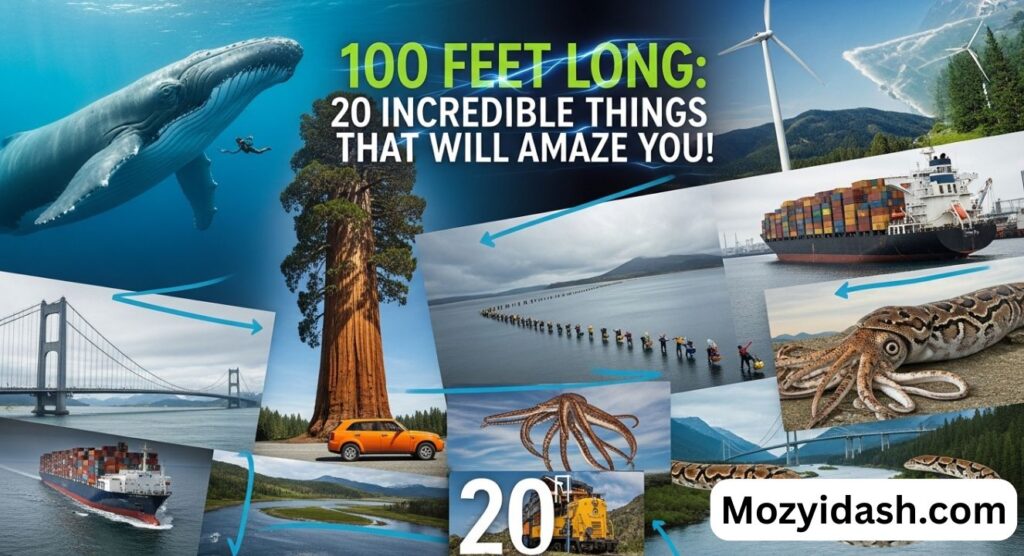
When people hear the term 100 feet long, they often underestimate its size. To visualize, think of walking the length of a basketball court and then adding a few more steps. That’s roughly 100 feet in length—a distance large enough to hold an entire blue whale or the height of a 10 story building.
Understanding how big is 100 feet helps put real-world length examples into perspective. This scale appears in architecture, nature, and sports, making it easier to compare objects that are 100 feet. Whether it’s a bridge section length, a wind turbine blade, or a Boeing 737, this measurement connects human engineering with the wonders of nature.
Everyday Things That Are 100 Feet Long
You don’t need to be an engineer to see things that are 100 feet long in daily life. From semi-trailer trucks parked end-to-end to the length of an Olympic swimming pool, 100 feet shows up more often than most people realize. It’s a common construction measurement and a key length comparison chart value.
Even natural wonders of size like the Eastern Cottonwood Tree height or blue whale size reach this length. These 100 feet examples in real life help us understand scale and proportion visually. Looking at these everyday measurement examples builds appreciation for both human-made and natural objects that are 100 ft in length.
Nature’s Giants: Living Things That Reach 100 Feet
In the natural world, large animals in nature and trees often measure around 100 feet long. The blue whale, for instance, is the largest creature on Earth and perfectly represents what is 100 feet in a living form. Its body length rivals a football field dimension divided into thirds.
Another fascinating example is the Eastern Cottonwood Tree, which grows to nearly 100 feet in height. These natural wonders of size help humans visualize scale and proportion through real-world length examples. Understanding how long is 100 feet through living examples connects us to the planet’s incredible biodiversity and power.
Engineering Marvels That Measure 100 Feet
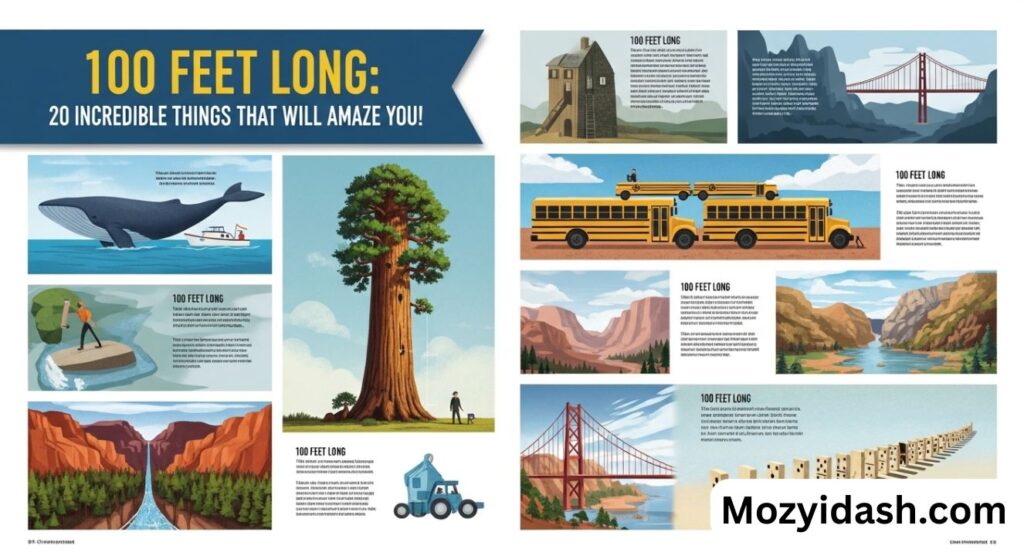
Modern engineering has countless objects that are 100 feet by design. For example, a Boeing 737-500 airplane or a bridge section length often matches this measurement. These are perfect 100 feet comparison cases showing how engineers use construction measurements for safety, balance, and function.
Wind turbine blades and ferris wheel spokes also stretch close to 100 feet in length. These machines demonstrate scale and proportion in real-world length examples, reminding us that innovation requires understanding size. In both energy and entertainment, things that measure 100 feet represent precision, strength, and creativity at work.
Visualizing Measurements: The Art of 100 Feet Comparison
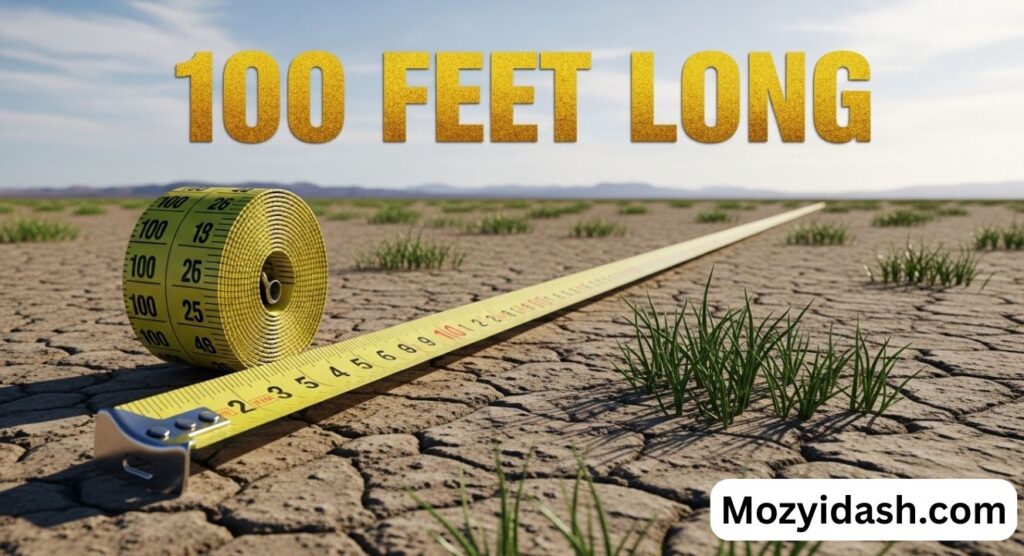
Many people struggle to imagine how big is 100 feet, so visualizing measurements through familiar scenes helps. Standing on a basketball court or beside a 10 story building height offers perspective. This comparison of large objects makes understanding distances easier for learners and curious minds.
Teachers, engineers, and designers often use a length comparison chart to explain 100 feet examples in real life. By comparing everyday measurement examples, like bowling lane length or kayaking equipment size, we better grasp scale and proportion. Learning what is 100 feet transforms abstract numbers into tangible experiences we can see and feel.
FAQ,s
What is 100 feet long?
Something that is 100 feet long measures about the length of a blue whale or a 10-story building, giving a clear idea of this impressive scale in real-world length comparison.
Is a football field 100 feet long?
No, an American football field is 300 feet long, so 100 feet equals roughly one-third of the field, making it easy to visualize this distance.
What is 100 feet long in meters?
100 feet in meters equals 30.48 meters, a useful figure often seen in construction measurements and length comparison charts worldwide.
How many cars are about 100 feet long?
If one car is about 15 feet long, then 100 feet equals the combined length of roughly six to seven cars parked end-to-end.
Conclusion
Understanding what is 100 feet gives us a new appreciation for both nature and human design. From blue whale size and eastern cottonwood tree height to the length of a basketball court or a semi-trailer truck length, each example offers a new perspective on 100 feet and how it shapes our world.
The comparison of large objects across sports, transportation, construction, and wildlife demonstrates how measurements connect every aspect of our daily lives. Next time you pass a building or see a large animal, take a moment to think about its scale—you might just be looking at something that’s 100 feet long.







